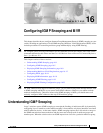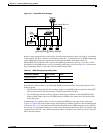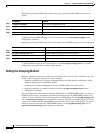
16-2
Catalyst 2950 Desktop Switch Software Configuration Guide
78-11380-05
Chapter 16 Configuring IGMP Snooping and MVR
Understanding IGMP Snooping
the switch adds the host port number to the forwarding table entry; when it receives an IGMP Leave
Group message from a host, it removes the host port from the table entry. It also periodically deletes
entries if it does not receive IGMP membership reports from the multicast clients.
Note For more information on IP multicast and IGMP, refer to RFC 1112 and RFC 2236.
The multicast router sends out periodic IGMP general queries to all VLANs. When IGMP snooping is
enabled, the switch responds to the router queries with only one join request per MAC multicast group,
and the switch creates one entry per VLAN in the Layer 2 forwarding table for each MAC group from
which it receives an IGMP join request. All hosts interested in this multicast traffic send join requests
and are added to the forwarding table entry.
Layer 2 multicast groups learned through IGMP snooping are dynamic. However, you can statically
configure MAC multicast groups by using the ip igmp snooping vlan static global configuration
command. If you specify group membership for a multicast group address statically, your setting
supersedes any automatic manipulation by IGMP snooping. Multicast group membership lists can
consist of both user-defined and IGMP snooping-learned settings.
If a port spanning-tree, a port group, or a VLAN ID change occurs, the IGMP snooping-learned multicast
groups from this port on the VLAN are deleted.
The switches support a maximum of 255 IP multicast groups and support both IGMP version 1 and
IGMP version 2.
In the IP multicast-source-only environment, the switch learns the IP multicast group from the IP
multicast data stream and only forwards traffic to the multicast router ports.
Joining a Multicast Group
When a host connected to the switch wants to join an IP multicast group, it sends an unsolicited IGMP
join message, specifying the IP multicast group to join. Alternatively, when the switch receives a general
query from the router, it forwards the query to all ports in the VLAN. Hosts wanting to join the multicast
group respond by sending a join message to the switch. The switch CPU creates a multicast
forwarding-table entry for the group if it is not already present. The CPU also adds the interface where
the join message was received to the forwarding-table entry. The host associated with that interface
receives multicast traffic for that multicast group. See Figure 16-1.


















